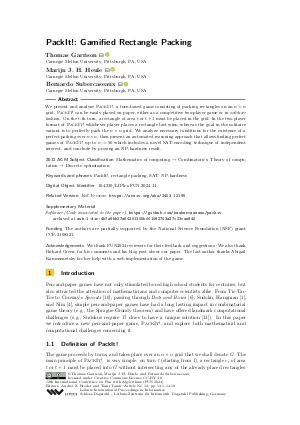PackIt!: Gamified Rectangle Packing
Authors
Thomas Garrison  ,
Marijn J. H. Heule
,
Marijn J. H. Heule  ,
Bernardo Subercaseaux
,
Bernardo Subercaseaux 
-
Part of:
Volume:
12th International Conference on Fun with Algorithms (FUN 2024)
Part of: Series: Leibniz International Proceedings in Informatics (LIPIcs)
Part of: Conference: International Conference on Fun with Algorithms (FUN) - License:
 Creative Commons Attribution 4.0 International license
Creative Commons Attribution 4.0 International license
- Publication Date: 2024-05-29
File

PDF
LIPIcs.FUN.2024.14.pdf
- Filesize: 0.85 MB
- 19 pages
Document Identifiers
Related Versions
- Full Version https://arxiv.org/abs/2403.12195
Subject Classification
ACM Subject Classification
- Mathematics of computing → Combinatorics
- Theory of computation → Discrete optimization
Keywords
- PackIt!
- rectangle packing
- SAT
- NP-hardness
Metrics
- Access Statistics
-
Total Accesses (updated on a weekly basis)
0PDF Downloads0Metadata Views
Abstract
We present and analyze PackIt!, a turn-based game consisting of packing rectangles on an n × n grid. PackIt! can be easily played on paper, either as a competitive two-player game or in solitaire fashion. On the t-th turn, a rectangle of area t or t+1 must be placed in the grid. In the two-player format of PackIt! whichever player places a rectangle last wins, whereas the goal in the solitaire variant is to perfectly pack the n × n grid. We analyze necessary conditions for the existence of a perfect packing over n × n, then present an automated reasoning approach that allows finding perfect games of PackIt! up to n = 50 which includes a novel SAT-encoding technique of independent interest, and conclude by proving an NP-hardness result.
Cite As Get BibTex
Thomas Garrison, Marijn J. H. Heule, and Bernardo Subercaseaux. PackIt!: Gamified Rectangle Packing. In 12th International Conference on Fun with Algorithms (FUN 2024). Leibniz International Proceedings in Informatics (LIPIcs), Volume 291, pp. 14:1-14:19, Schloss Dagstuhl – Leibniz-Zentrum für Informatik (2024)
https://doi.org/10.4230/LIPIcs.FUN.2024.14
BibTex
@InProceedings{garrison_et_al:LIPIcs.FUN.2024.14,
author = {Garrison, Thomas and Heule, Marijn J. H. and Subercaseaux, Bernardo},
title = {{PackIt!: Gamified Rectangle Packing}},
booktitle = {12th International Conference on Fun with Algorithms (FUN 2024)},
pages = {14:1--14:19},
series = {Leibniz International Proceedings in Informatics (LIPIcs)},
ISBN = {978-3-95977-314-0},
ISSN = {1868-8969},
year = {2024},
volume = {291},
editor = {Broder, Andrei Z. and Tamir, Tami},
publisher = {Schloss Dagstuhl -- Leibniz-Zentrum f{\"u}r Informatik},
address = {Dagstuhl, Germany},
URL = {https://drops.dagstuhl.de/entities/document/10.4230/LIPIcs.FUN.2024.14},
URN = {urn:nbn:de:0030-drops-199226},
doi = {10.4230/LIPIcs.FUN.2024.14},
annote = {Keywords: PackIt!, rectangle packing, SAT, NP-hardness}
}
Author Details
Funding
The authors are partially supported by the National Science Foundation (NSF) grant CCF-2108521.
Acknowledgements
We thank FUN2024 reviewers for their feedback and suggestions. We also thank Richard Green, for his comments and his blog post about our paper. The last author thanks Abigail Kamenenetsky for her help with a web implementation of the game.
Supplementary Materials
-
Software (Code associated to the paper)
https://github.com/bsubercaseaux/packit
browse
 archived version
archived version
References
- Jérémy Barbay and Bernardo Subercaseaux. The Computational Complexity of Evil Hangman. In Martin Farach-Colton, Giuseppe Prencipe, and Ryuhei Uehara, editors, 10th International Conference on Fun with Algorithms (FUN 2021), volume 157 of Leibniz International Proceedings in Informatics (LIPIcs), pages 23:1-23:12, Dagstuhl, Germany, 2020. Schloss Dagstuhl - Leibniz-Zentrum für Informatik. URL: https://doi.org/10.4230/LIPIcs.FUN.2021.23.
-
Edward J Barbeau. Pell’s Equation. Problem Books in Mathematics. Springer, New York, NY, 2003 edition, January 2003.

-
Armin Biere, Katalin Fazekas, Mathias Fleury, and Maximillian Heisinger. CaDiCaL, Kissat, Paracooba, Plingeling and Treengeling Entering the SAT Competition 2020. In Tomas Balyo, Nils Froleyks, Marijn Heule, Markus Iser, Matti Järvisalo, and Martin Suda, editors, Proc. of SAT Competition 2020 endash Solver and Benchmark Descriptions, volume B-2020-1 of Department of Computer Science Report Series B, pages 51-53. University of Helsinki, 2020.

- Charles L. Bouton. Nim, A Game with a Complete Mathematical Theory. Annals of Mathematics, 3(1/4):35-39, 1901. URL: https://doi.org/10.2307/1967631.
- Ron Breukelaar, Erik D. Demaine, Susan Hohenberger, Hendrik Jan Hoogeboom, Walter A. Kosters, and Dadvid Liben-Nowell. Tetris is Hard, Even to Approximate. International Journal of Computational Geometry & Applications, 14:41-68, April 2004. URL: https://doi.org/10.1142/S0218195904001354.
- Kevin Buchin, Mart Hagedoorn, Irina Kostitsyna, and Max van Mulken. Dots & boxes is PSPACE-complete, 2021. URL: https://arxiv.org/abs/2105.02837.
-
Erik. D Demaine, William Gasarch, and Mohammad Hajiaghayi. Computational Intractability: A Guide to Algorithmic Lower Bounds. https://hardness.mit.edu/.

- Pierre Dusart. Autour de la fonction qui compte le nombre de nombres premiers. PhD thesis, Université de Limoges, 1998. Thèse de doctorat dirigée par Robin, Guy Mathématiques appliquées. Théorie des nombres Limoges 1998. URL: http://www.theses.fr/1998LIMO0007.
-
Natalia García-Colín, Dimitri Leemans, Mia Müßig, and Érika Roldán. There is no perfect mondrian partition for squares of side lengths less than 1001. arXiv preprint arXiv:2311.02385, 2023.

- Martin Gardner. Mathematical games. Scientific American, 223(4):120-123, October 1970. URL: https://doi.org/10.1038/scientificamerican1070-120.
- MIT CompGeom Group, Zachary Abel, Hugo A. Akitaya, Erik D. Demaine, Adam C. Hesterberg, and Jayson Lynch. When can you tile an integer rectangle with integer squares?, 2023. URL: https://arxiv.org/abs/2308.15317.
- Heather Hulett, Todd G. Will, and Gerhard J. Woeginger. Multigraph realizations of degree sequences: Maximization is easy, minimization is hard. Operations Research Letters, 36(5):594-596, September 2008. URL: https://doi.org/10.1016/j.orl.2008.05.004.
- Gary McGuire, Bastian Tugemann, and Gilles Civario. There is no 16-clue sudoku: Solving the sudoku minimum number of clues problem, 2013. URL: https://arxiv.org/abs/1201.0749.
- Cooper O'Kuhn. The mondrian puzzle: A connection to number theory, 2018. URL: https://arxiv.org/abs/1810.04585.
- Lowell Schoenfeld. Sharper Bounds for the Chebyshev Functions θ(x) and ψ(x). II. Mathematics of Computation, 30(134):337-360, 1976. URL: https://doi.org/10.2307/2005976.
